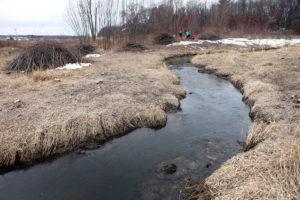
Due to the cyclical nature of the hydrologic cycle, removal of groundwater can reduce surface water in lakes and streams. (Photo credit: The Capital Times archives)
The hydrologic cycle describes the circulation of water from the ocean and other watery surfaces to the atmosphere and to the land.
A major source of atmospheric water vapor is evaporation from the oceans. Precipitation — rain, snow, sleet or freezing rain — falls from clouds and is a loss of atmospheric water as it removes water from the atmosphere.
Precipitation returns water to the Earth’s surface and is a source of water for land. Precipitation on land may collect in lakes, run in rivers back to the ocean or percolate into the soil.
The hydrologic cycle is an interactive system. Water in the atmosphere, in the ocean, on land and underground is linked, and changing one modifies the others.
Since water plays a major role in weather and climate, it is important to understand the hydrologic cycle. A change in one component of the hydrologic cycle can affect weather. For example, a decrease in the amount of cloud cover over land during the day will allow more solar energy to reach the surface and warm the ground and the atmosphere above.
Another example is how an increased frequency in intense precipitation events over land areas can lead to flooding rather than waters seeping into aquifers.
While the hydrologic cycle is a global phenomenon, there are regional aspects that impact Wisconsin as hydrological changes across watersheds impact water supply. With ongoing climate change, shifts in precipitation patterns can impact water resources and thus management practices.
A drop in precipitation over a watershed will reduce the amount of surface waters and thus percolation into the ground. Most Wisconsin residents get their drinking water from groundwater.
Similarly, because of the cyclical nature of the water cycle, removal of groundwater can reduce surface water in lakes and streams. Groundwater recharge, water filtration and flood prevention practices may have to adapt to our observed regional climate change. Such adaptations need to consider the water cycle as an interactive system and not an isolated event.

